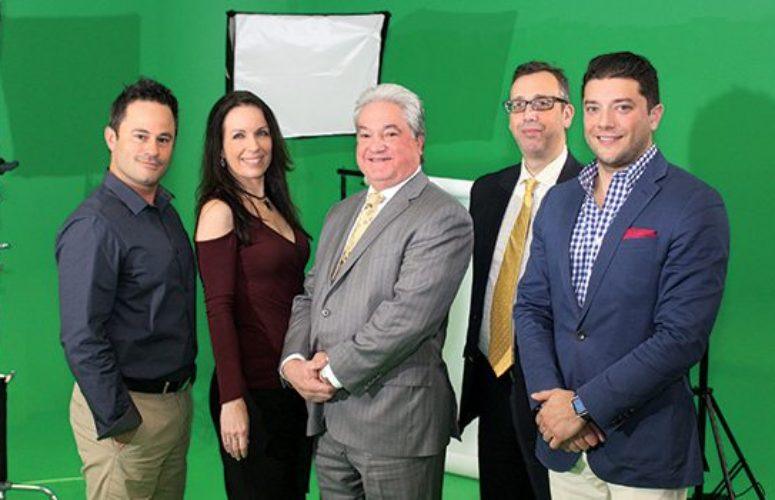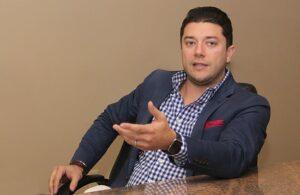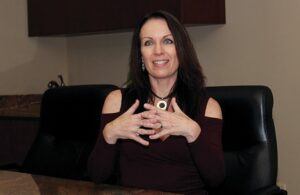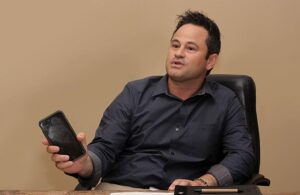
Good or Bad, Technology Drives Marketing Today
Then again … it always has!
By Anthony Birritteri, Editor-in-Chief On Dec 30, 2016In this next installment of our Trade-talk Roundtable series, New Jersey Business sits down with five marketing experts to discuss the impact digital technology is having on the marketing message. From the gathering of personal data and dealing with society’s shortened attention span to the growth of fragmented media outlets, the creative message (and the talent behind the message) – for better or for worse – is being altered.
We would like to thank the NJ Ad Club for arranging this panel and SGW Integrated Marketing and Communications for hosting the event. Before the Q&A, we would like to introduce Roundtable participants. Their biographies appear in order corresponding to the photo above (left to right).
Nick Mamola is senior vice president, agency strategist, at Marketsmith Inc., a Cedar Knolls-based marketing technology and creative agency. His responsibilities include new business development, overseeing key client relationships, and leading the agency’s omnichannel strategy. Mamola has 23 years of experience working with a diverse client base across multiple industries. He has worked with Fiore & Associates, Source Communications, Grybauskus Beatrice, Blue Dingo Digital, Digitas, Korey Kay & Partners, and The Gate Worldwide. His client experience includes: Nikon, Kraft Foods, Subway Restaurants, American Express, Century 21, MCI Worldcom, Hewlett-Packard, Samsung, MTA (Metropolitan Transit Authority), Lexar, Everlast Nutritional Supplements, Jose Cuervo, CURE Auto Insurance, Jeffrey Modell Foundation and Wynn Resorts.
Denise Blasevick co-founded Boonton-based The S3 Agency in 2001 to be “the New York agency in New Jersey,” bringing Madison Avenue creativity to the Garden State. At S3, she has pioneered groundbreaking communications campaigns for international brands such as Aston Martin, BMW of North America, and Tetley Tea as well as for local organizations, like Turtle Back Zoo. Blasevick has received hundreds of awards for her creativity and her business acumen, including “New Jersey’s Best 50 Women in Business” and induction in the “Advertising Hall of Fame of New Jersey.” She also serves on the Board of Trustees for the Zoological Society of New Jersey.
David Scelba is founder and chairman/CEO of Montville-based SGW Integrated Marketing Communications, 3E Public Relations (SGW’s PR division), Impact | SGW (a co-op advertising division), Digital To Dealer Direct (a digital retail division), and Changebridge Productions (a video, animation and multi-media production company). These affiliated companies all share Scelba’s “3E” marketing philosophy: Entertain, Educate and Engage. Scelba is also a consultant to the broadcast, computer and telecom industries and, since the 1980s, has been at the forefront of technology convergence. In 2012, Scelba was inducted into the “Advertising Hall of Fame” of New Jersey in recognition of his leadership, creativity, professional integrity and personal involvement in the New Jersey marketing and communication community.
Franco Zito is president of the NJ Ad Club and senior director of research & marketing, New York DMA, for Comcast Spotlight. He began his career at Comcast in 2003, creating the research department for the New York sales office. He is a two-time member of Comcast Spotlight’s President’s Club and a past Board member of the Cable & Telecommunications Association for Marketing’s New York chapter. A cable research veteran, Zito also worked in the cable division of Nielsen Media Research where he serviced national, regional and local cable networks as well as local cable operators over his 12-year span with the company.
Leon Grassi is director of marketing & business development at The DSM Group, a Franklin Lakes-based full-service marketing, advertising and public relations agency. Through media, publishing, IT and financial services, Grassi honed his skills at business and ultimately relationship development. He defines himself as a marketing strategist, and leverages both his personal experiences as well as those around him to deliver effective marketing solutions for his clients. He believes that business is simply about people and their drive to be successful. Grassi is a graduate of Fordham University with a B.S. in Marketing and Advertising. He resides in Mahwah with his wife and two children.
Q: How difficult is it to keep up with technology in order for you to help your clients?

Franco Zito, of the NJ Ad Club
Zito: From an industry perspective, a lot of [Ad Club] members are driving the technology change, staying a step ahead of it and providing solutions for clients.
Scelba: Truthfully, it is impossible for one person to become an expert in all areas; search engine optimization, social media, paid digital, the measurements matrix, etc. So what we have now are teams.
Agencies and firms are becoming affiliates. If we could pull our resources together as a team, instead of being competitors, we will bring great benefits to clients.
Blasevick: I don’t think any client imagines that one agency can do absolutely everything. However, if you have good consultative relationships with your clients, they are willing to let you bring in people to help. However, I find it is generally better when there is a lead agency to bring in the other pieces via partnerships because one strategy should be set by an agency that the others strive to fulfill.
Technology is changing, but what hasn’t changed is “what is the meaning of a brand” … having the brand fundamentals. To me, strategy is still king; brand is still king. If you have a differentiated product or service that people really want, and you uphold that brand experience all the time, then you put together a strategy to support it. Then you look at what should we be doing digitally.
Grassi: The pace of change in business in general these days is so much quicker, and technology has been an enabler of that as much as it has been a curse. It is fundamentally changing the way we communicate and absorb the data.
Data is the great equalizer. I may be old fashioned in saying I don’t necessarily think that it is a good thing. I cut my teeth working for ad sales reps who cut their teeth selling ad space in New York City in the ‘70s and ‘80s. These guys instilled in me, early on, that nothing beats a relationship. And I feel there has been a breakdown in relationship development – in any business, but particularly ours – because we are leveraging technology too much.
I don’t think, as an industry, that we will be able to stay ahead of technology. I think the best we can do is leverage the generation who understands what its capabilities are and learn from them.
Blasevick: We are learning new technologies from Millennials, but it has always been like that. It has always been young people bringing in new trends.
Q: I heard at a Marketsmith event that you have eight seconds to grab someone’s attention. How is the quick pace of communications changing the way you deliver the message?

Dave Scelba of SGW
Scelba: You are right about the eight seconds, but getting people’s attention and keeping them has always been the norm, from the traditional to the non-traditional mediums.
Technology has gotten us to the point of instantaneous gratification. But getting one’s attention is key. It’s like our tag line for 3E PR: Entertain, Educate and Engage.
Blasevick: When you are talking about YouTube, you need to be “un-ignorable” for the five seconds before you skip an ad. Un-ignorable is more important than it has ever been because there are so many ads coming at us from different places, at all times. But if it is something someone is interested in at that moment, they will click through. So, I think there is more opportunity for a brand to develop more of a relationship in this fast-paced arena, when it matters.
Mamola: We are story tellers; we always have been. That fact is that whether we are telling a story through a 60-second spot, 30-second spot or, now, a 10-to-5-second spot, we have to do it in a much more fragmented environment. However, it comes down to relevancy … understanding again who the customers are and segmenting a little deeper now than we did before. We don’t group them as much. We create personas. We look at what motivates them and communicate to them more appropriately. When they are engaging, they want to because it is relevant to them. It’s not the shotgun approach it once was.
Grassi: There is something that needs to be said about the shortness and the attention span. I think it opens the door for people to try things they haven’t tried before. Many agencies are pushing the boundaries these days. What it boils down to is being salacious. There is a reason humor has had such tremendous impact over the last few years.
I think there is a willingness to push the envelope by taking advantage of the technology platforms and capturing attention.
Blasevick: Even for the biggest of brands, we always suggest that our clients set aside part of their budget for the unknown … it could be a last minute idea. Some money may go down the drain because you have to find out what works and what doesn’t work. But if something is right, it’s like a winning lottery ticket.
Grassi: We can’t downplay culture. Twenty to 30 years ago in business, culture was a four letter word. Now when a business embraces the meaning of culture, identifies that culture and embraces change and technology, man that makes our jobs so much easier.
Blasevick: Every company has a culture, either by design or by default. If your culture doesn’t line up with your brand, you are undermining your brand … your brand is a sham.
Mamola: It’s authenticity, and digital and technology has allowed that to shine through. Years ago, we were able to define a brand to our consumers. Now consumers are starting to define the brand for us through social media. How you handle that is a big part of it.
Scelba: We are in the business of creating perception for clients and creating their brand. But the thing is, you just can’t create a perception anymore. Perception has to be reality. There is no way to hide today. Your brand has got to be honest.
Q: How has fragmentation been a challenge for you and what is good about it?

DSM’s Leon Grassi
Grassi: We are ADHD … by design almost … these days. The fragmentation in the messaging is relevant just based on the fact that is how most people live their daily lives. We are fragmented, and technology has enabled that. So, the hard part is maintaining the messaging across the board. As a media guy back in 2000s, it was all about reach and frequency … as many times as you could and the consistency in the messaging. Today, it’s about the right message at the right time to the right audience, which literally changes weekly.
Mamola: Instead of trying to keep up with the different [media] platforms and channels, the technology is about keeping up with consumers. Where are the consumers on their journey? It’s understanding the audiences better, and serving up relevant messages and content at the right time.
We know who they are, and what their interests are at a much deeper level than we had before.
Scelba: Sometimes, I think that we target so much on our specific audiences that we are not addressing or trying to convert possible audiences. When we do so much fragmentation and segmentation, I wonder if we are leaving a little bit out [other audiences]?
Mamola: You are right. We are getting too targeted in talking to the perfect audience, telling them exactly what they want and why the product is perfect. It is also important to take a step back and say, “Who am I missing?”
Q: How do most of your clients view print advertising today?
Scelba: If you are using print, that print should have other properties: websites, microsites, YouTube channels.
Blasevick: I think it is seen as high touch, depending on the type of brand or product. People still like reading magazines; Millennials like magazines. There is something to that feeling.
Mamola: It depends on the audience, what kind of message you have and how does it play to the overall media mix. That said, print is dying from where it once was, but for the right audience and right brand it make sense.
Grassi: Today may mark the hundredth thousandth time in my professional career that I have heard that print is dying. The New York Times and The Wall Street Journal are still in print against all odds. There is a reason for that: because of the value print still has in marketing and advertising. I still believe, in my heart of hearts, that there is something glamorous about print and there always will be. There is a deeper connection to print than there is in the digital space.
Q: With so many social media outlets, how do you help a client decide which ones to participate in?

Denise Blasevick, of The S3 Agency
Blasevick: It depends on the client. If I am working with a funeral home, I am probably not going on Facebook. (Jokingly) Maybe I am if none of their competitors are there. You really have to look at where you can put enough value behind something to make a meaningful relationship in the community. Ideally, should brands be all over the place? Probably. Perhaps it is enough to own one particular area. If you are going to be the “Snapchat funeral home,” and that is resonating with Millennials, then maybe it is.
Scelba: With social media, I think the first thing you’ve got to do is conduct an audit. Where is the target audience? After you do the audit, then you can come back with recommendations on whether a client should be on Facebook, Instagram, Twitter or LinkedIn, etc.
Also, content should not be repurposed everywhere. That is a mistake a lot of clients make. It’s not creating a TV spot and then editing that down to an online video. The same thing happens in social. If you are going to put the same thing on Facebook, on Instagram, on Snapchat, it’s not working.
Grassi: Mark Zuckerberg don’t strike me down, but I don’t know that advertising on Facebook is the right practice. The way we approach it and instruct our clients is, as a platform, it works best from an influencer’s standpoint. To me, the value of social is not posting an ad. The influence is where the value is in social. What we say to our clients is, “Let’s go to the platform where most of your influencers exist. That is where we think we are going to get the most bang for our buck.” The great part about social, if you do it right, is that it shouldn’t cost a lot of money. I believe in developing an audience, finding value in that audience and letting that audience sell your product or service for you.
Blasevick: What has been nice about social media is that it has allowed heritage brands the opportunity to expand their brand personality. For some who have done it well, they have taken that and put it through other channels.
Scelba: Social has become the first line of a client’s service department. Before people call the company for help with an issue or problem, they go right to the socials and post a complaint. It is immediate. What we all do, by monitoring their engagement on social, is report right back to them. That is why the 24/7 monitoring is so important. It might be someone posting something about a bank at 9 p.m., on a Sunday. Our people have to be on top of that.
Blasevick: We, as marketers, have always said that we want a true dialogue with our customers. Well, hello, we have it now, so be careful what you wish for.
Q: To the minutest detail, what data can you obtain about someone?

Nick Mamola, of Marketsmith, Inc
Mamola: We can get almost anything, especially because of cell phones. We work with partners who know where you are every second and what you do every moment, and we use that to market. The reality is we are still using such a small amount of data compared to the data that is actually available.
Clients and companies just don’t know how to get it. It’s siloed … and who owns what piece? Then it’s the typical garbage in and garbage out. How good is the data and how clean is it? Our platform, i.Predictus, actually brings in data from many sources. It is cleansed automatically and we are able to visualize that data and compare it.
The key thing is understanding those KPI (key performance indicators): “What are we really looking to measure?” More data confuses people. Our clients say, “Data is great, let’s get more,” because they don’t know what they are looking for.
Scelba: There are so many aggregators of data, and clients don’t know what to do with it. They are looking to us to make it simple and give them a summary of what they should do with it.
Zito: I have to say, though, from an industry perspective, it sounds very scary – that big brother is watching you – but privacy is the utmost concern for everybody. You hear these things about knowing where people are every second of the day. But it is not that people know who you are. There is a big push in the industry to make people aware that we are respecting their privacy.
Mamola: We know down to the device number, where you are. We won’t put a name to it. We then categorize you and group you and market to you. The other part of it is that consumers are more empowered and understand a little bit more of what is going on. They can set their preferences so that they can be marketed to, as long as it is relevant.
Blasevick: I think there is a false sense of security that western-world consumers have been lulled into until something terrible happens. There are hackers out there. Something is going to happen at some point.
Grassi: As a liability question, I can tell you, with confidence, that anyone in this room is three Chrome extensions away from getting free information on people you never thought would be possible. People don’t even realize how much they are sharing.
However, my biggest concern as a marketer is that creative is starting to suffer because of the data. Just because you could put a message in front of the right person at the right time, doesn’t mean the message is going to be successful if it’s boring, not on point or not sexy. Unfortunately, we, as an industry, have started to embrace robotic marketing and that is terrifying. We need to shift our focus back to brilliant creative – and yes leverage the data – but put those two things together.
Scelba: Our creative product, our IP, is what is going to sustain us. Today, we have learning computers, like Watson. They may be able to take certain components of the data and put a report together, but they are not going to be able to develop content and creative because that is a human element. That is something I don’t believe, at least in my lifetime, we will see.
Grassi: Do you know what is ironic? This word keeps on popping up: We are constantly trying to “humanize” our clients and their brands, products and services, and I am asking, “Why?” Why should we have to humanize something which is clearly human? The machines are taking over. “Terminator” is happening. We are finding ourselves having to “humanize” something which should obviously be human. … And that’s crazy. There is a trend here and it’s terrifying.
Related Articles:






